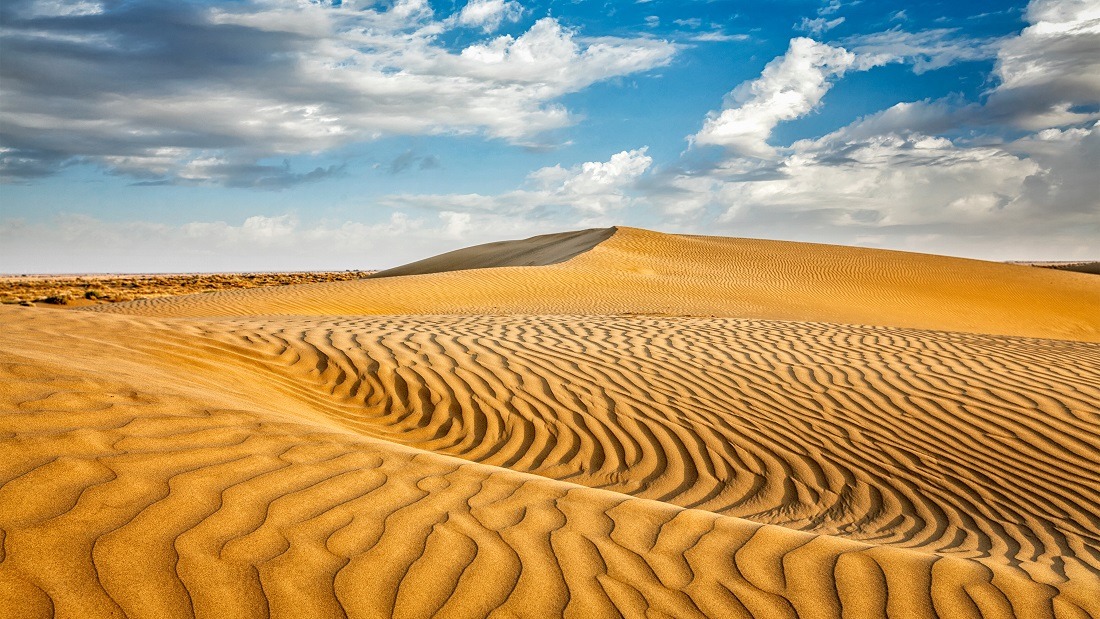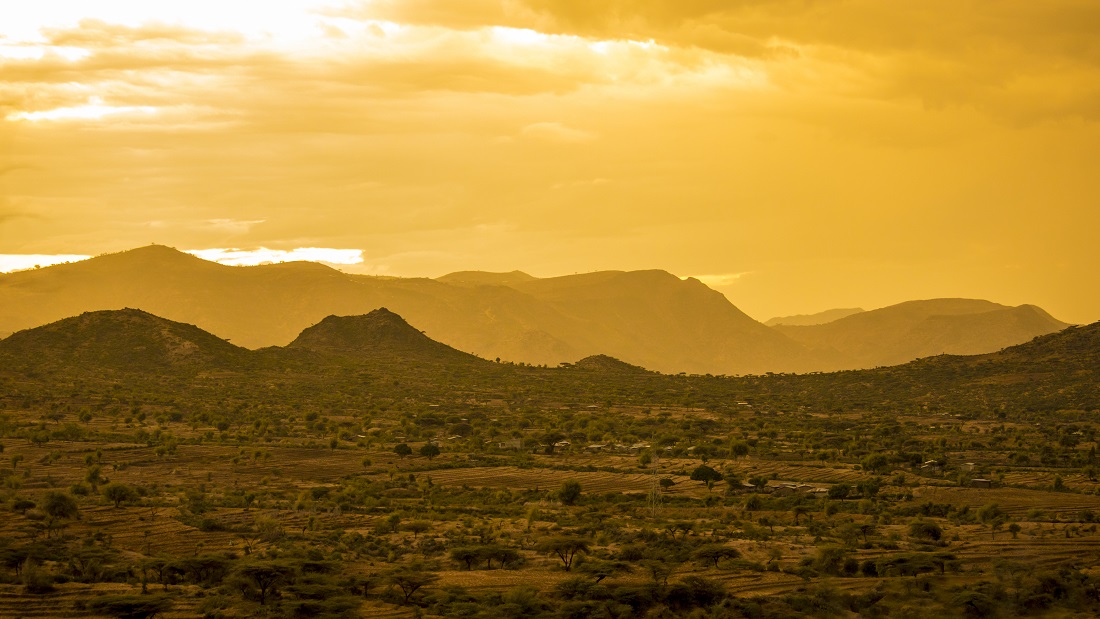Desertification

Around one-quarter of the world’s land is turning into desert, unable to support vegetation or wildlife. Desertification and land degradation are being driven by climate change and the expansion of livestock farming, with overgrazing and deforestation as two of the main causes. Land degradation is not just happening in hot, dry countries, it’s occurring all over the world; including the UK and the US. The situation is likely to worsen as a result of global warming. Drastic action is required immediately if we are going to try to prevent a climate crisis. High consumption of meat and dairy products is fuelling the problem; switching to a vegan diet would stop this relentless assault on the world’s soils and permit recovery.
What is desertification?
Desertification is when not existing deserts advance and gain ground. It is land that is overexploited, dry and no longer fertile becoming desert. It is causing major environmental and socioeconomic problems in many areas of the world. Globally, more than 12 million hectares of arable land are lost to desertification every year.4UNEP. 2011. Global Drylands: A UN system-wide response. https://www.unep-wcmc.org/resources-and-data/global-drylands–a-un-system-wide-response
Desertification and land degradation occur when fertile land is transformed in such a way that it loses the capacity to support vegetation or wildlife. It is caused by a variety of factors including climate change (particularly global warming) and the overexploitation of soil, for example, through overgrazing or deforestation. The land becomes increasingly arid, or dry, as it loses water and vegetation, which plays a vital role in maintaining land integrity, until it can no longer support life.
Dr Alan Grainger, Senior Lecturer in Global Change and Policy at the University of Leeds says that desertification is the ‘Cinderella of global environmental change’, with the potential to affect 40% of the Earth’s surface and 32% of the human population, but compared to global climate change, it receives little attention.5Grainger A, Stafford Smith M, Squires VR et al. 2000. Desertification, and climate change: the case for greater convergence. Mitigation and Adaptation Strategies for Global Change. 5, 361-377.
Drylands currently cover around 40% of the world’s land area and support some 50% of the world’s livestock – as well as two billion people; 90% of whom live in developing countries.1UNEP. 2011. Global Drylands: A UN system-wide response. https://www.unep-wcmc.org/resources-and-data/global-drylands–a-un-system-wide-response Found on all continents, but being most prevalent in Africa and Asia, drylands include some of the world’s biggest cities such as Cairo, Mexico City and New Delhi. Unsustainable land and water use and the impacts of climate change are driving the degradation of drylands around the world.1UNEP. 2011. Global Drylands: A UN system-wide response. https://www.unep-wcmc.org/resources-and-data/global-drylands–a-un-system-wide-response
In semi-arid areas like Africa, land is increasingly used for extensive farming of crops which are not used to feed the local human population but are exported to developed countries as cattle feed or used for cattle grazing. Scientists state that this use of land is a responsible for much desertification.6Baroni L, Cenci L, Tettamanti M et al. 2007. Evaluating the environmental impact of various dietary patterns combined with different food production systems. European Journal of Clinical Nutrition. 61 (2) 279-286.
Case study: The Sahel

The disastrous impacts of desertification can be seen in the Sahel; a region spanning North Africa, below the Sahara Desert. It includes parts of Burkina Faso, Chad, Djibouti, Eritrea, Ethiopia, Mali, Mauritania, Niger, Nigeria, Senegal and Sudan. Rainfall is low (4-24 inches per year) and droughts are frequent. It is one of the world’s largest water-limited environments and is particularly vulnerable to climate change and human activities.
Traditionally here, land had been cleared for crops, but over the years, without shelter from trees, the topsoil has dried and blown away. Rainfall runs off instead of soaking into cropland and the level of desertification has been very high. However, in the last 20 years, there has been some ‘regreening’ of the Sahel, through the planting of trees and vegetation recovery.1Kaptué AT, Prihodko L and Hanan NP. 2015. On regreening and degradation in Sahelian watersheds. Proceedings of the National Academy of Sciences. 112 (39) 12133-12138. Some areas of land have been restored by local community initiatives nurturing plants and trees and protecting young sprouts from cattle and other hazards. However, mitigating climate change’s impact on the Sahel by planting trees, is not enough. Averting disaster requires addressing the climate crisis directly.
NASA’s senior water scientist, Dr James Famiglietti, told the Huffington Post that the 2015 action film Mad Max: Fury Road is pretty extreme but that elements of it could be possible: “Of course, there are desert regions on Earth that already look like that – like those in the film – so the question is, will more of Earth’s wet regions be converted into dry ones? Our climate models certainly predict increasing ‘desertification,’ which will be particularly difficult for those regions, like the Sahel, that are on the boundary between wet and dry. There are metaphorical elements of ‘Mad Max’ that are already happening, and that will only worsen with time.”2Howard J. 2016. ‘Mad Max’ Is A Lot Scarier When You Realize That’s Where We Could Be Headed. www.huffingtonpost.com/entry/mad-max-fury-road-climate-change_us_56d4669de4b0871f60ec0926
Sandstorm cities
In recent years, more and more sandstorms that form in desert areas have swept into cities in Africa, the western US, Australia and north-western China.1Feng Q, Ma H, Jiang X et al. 2015. What Has Caused Desertification in China? Scientific Reports. 5, 15998. Half the land in China is made up of drylands and the increasing frequency of dust and sandstorms within dryland regions is causing major concern. Creeping desertification is swallowing thousands of square kilometres of productive soil every year. The Gobi desert, which spans China and Mongolia, is the world’s second largest dust source, after the Sahara. Although the desert itself is some distance from Beijing, reports suggest that large sand dunes are forming not far from the city.
The Chinese government have implemented a series of large-scale mitigation programs focusing on increasing vegetation cover by prohibiting grazing, planting trees and grasses, and constructing shelter forests to protect farmland against blowing sand. This has helped in some areas but not in others – where desertification has continued to expand. Some scientists question the effectiveness of planting trees in drylands and especially in arid areas that lack sufficient rain to sustain trees in the long term.1Feng Q, Ma H, Jiang X et al. 2015. What Has Caused Desertification in China? Scientific Reports. 5, 15998.
It is not only drylands that are affected; desertification is a major problem in Iceland, for example, despite ample rain in most parts of the country.2Arnalds A. 2004. Carbon sequestration and the restoration of land health. An example from Iceland. Climatic Change. 65, 333-346. Land and soil erosion are one of the country’s chief environmental problems. It is believed that more than 95% of Iceland’s forests and over half of its contiguous soil cover have been lost since the time the island was settled in the year 874, as a result of a combination of the harsh climate and intensive land use by the agricultural sector.3Ministry for the Environment of Iceland, 2007. Iceland’s Climate Change Strategy.

Land degradation
In the UK, agricultural soils are being degraded by intensive farming practices, with deep ploughing, short rotation periods and exposed ground leading to soil erosion from wind and heavy rain. The rate of loss is not sustainable, as soil can take a hundred years or more to form. Water shortages and drier soil conditions, that are likely with climate change, are jeopardising farming in areas like the East Anglian Fens, leading to an increased reliance on imports.1Committee on Climate Change. 2015. Reducing emissions and preparing for climate change: 2015 Progress Report to Parliament. www.theccc.org.uk/wp-content/uploads/2015/06/6.736_CCC_ASC_Adaptation-Progress-Report_2015_FINAL_WEB_070715_RFS.pdf
Maize is considered a high-risk erosion crop as the plants leave soil exposed during much of the growing season. Where maize is replacing grassland, the risks of erosion are even higher, especially if it is planted on slopes. From 1988 to 2014, there was a seven-fold increase in the area of land in the UK planted with maize (from 27,000 to 196,000 hectares). Of this, much is grown in the Southwest. Most of the maize grown in the UK is used to feed livestock with around 15% (29,000 hectares in 2014) used to produce bio-energy.1Committee on Climate Change. 2015. Reducing emissions and preparing for climate change: 2015 Progress Report to Parliament. www.theccc.org.uk/wp-content/uploads/2015/06/6.736_CCC_ASC_Adaptation-Progress-Report_2015_FINAL_WEB_070715_RFS.pdf
In the US, about 90% of cropland loses soil every year at a rate 13 times above the sustainable rate of one ton per hectare, per year, and pastures and rangelands are losing soil at an average of six times that. Furthermore, about 60% of pastureland in the US is being overgrazed and is subject to accelerated erosion.2Pimentel D and Pimentel M. 2003. Sustainability of meat-based and plant-based diets and the environment. American Journal of Clinical Nutrition. 78 (3 Suppl) 660S-663S.
Extreme drought contributes to desertification too, as seen in California. Forests of California are of particular interest because they include the tallest, biggest and oldest trees on Earth. They provide a habitat for numerous plant and animal species, carbon storage for climate change mitigation, water provisioning for a myriad of industries and communities and timber for wood products and ecotourism.3Asner GP, Brodrick PG, Anderson CB et al. 2016. Progressive forest canopy water loss during the 2012-2015 California drought. Proceedings of the National Academy of Sciences. 113 (2) E249-55. Some estimates suggest that that up to 150 million trees have died in California since the drought began in 2011. A study in Nature Geosciences suggests more suffering is in store for forests as the climate heats up.4Goulden ML and Bales RC. 2019. California forest die-off linked to multi-year deep soil drying in 2012-2015 drought. Nature Geoscience. 12, 632-637.
Soils are a non-renewable natural asset, critical for crop production, but they also provide a range of wider benefits, including slowing the water cycle and carbon storage. ‘Soil organic carbon’ is the carbon stored in soil in organic plant and animal materials at various stages of decay.
In a 2009 Department for Environment, Food and Rural Affairs (Defra) report titled Safeguarding our Soils, the government says that they recognise the importance of soils in the fight against climate change. UK soils, they say, contain 10 billion tonnes of carbon – more than is stored in all the trees in Europe.5Defra. 2009. Safeguarding our soils: A strategy for England. www.gov.uk/government/publications/safeguarding-our-soils-a-strategy-for-england This amount dwarfs the 0.2 billion tonnes of carbon stored in UK vegetation1Committee on Climate Change. 2015. Reducing emissions and preparing for climate change: 2015 Progress Report to Parliament. www.theccc.org.uk/wp-content/uploads/2015/06/6.736_CCC_ASC_Adaptation-Progress-Report_2015_FINAL_WEB_070715_RFS.pdf and is equivalent to more than 50 times the UK’s current annual greenhouse gas emissions.5Defra. 2009. Safeguarding our soils: A strategy for England. www.gov.uk/government/publications/safeguarding-our-soils-a-strategy-for-england
Due to losses of soil organic carbon, around 12 million tonnes of carbon dioxide is emitted to the atmosphere each year from UK soils.1Committee on Climate Change. 2015. Reducing emissions and preparing for climate change: 2015 Progress Report to Parliament. www.theccc.org.uk/wp-content/uploads/2015/06/6.736_CCC_ASC_Adaptation-Progress-Report_2015_FINAL_WEB_070715_RFS.pdf The government says that they recognise the issue and there is an ambition for all soils to be used sustainably by 2030. As the climate warms and rainfall patterns change, there is a growing risk that emissions to the atmosphere from soil will increase, in turn causing further climate change as well as reducing the soil’s productive capacity.
There is a clear need for transformative change in land management and food production systems in order to address the global climate crisis and combat land degradation and desertification. Going vegan is the most effective way to reduce pressure on the world’s limited resources and achieve food security for all.




